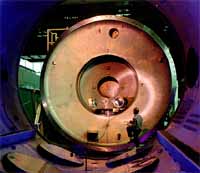Among the exciting
revolutionary technologies that Deep Space 1 tested in space are:
 An ion
propulsion engine prototype undergoes testing in a vacuum chamber.
An ion
propulsion engine prototype undergoes testing in a vacuum chamber.
|
SOLAR
ELECTRIC ION PROPULSION
Unlike chemical rocket engines, ion engines
accelerate nearly continuously, giving each ion a tremendous burst of
speed.
The DS1 engine provides about 10 times the specific impulse (ratio
of thrust to propellant used) of chemical propulsion.
AUTONOMOUS
OPTICAL NAVIGATION
Using images of asteroids and stars collected
by the onboard camera system, the onboard navigator system computes and
corrects
the spacecraft's course. Earlier spacecraft navigation systems relied
on human controllers on Earth.
BEACON MONITOR OPERATIONS
This
technology will eventually reduce the need for mission controllers on
Earth to monitor the health of the
spacecraft at all times. The spacecraft's
beacon monitor has the capability to beam one of four signals to Earth
summarizing
its status and indicating the urgency of its need for human intervention.
SOLAR
CONCENTRATOR ARRAY
The advanced solar concentrator arrays that
provide power to the ion engine are more efficient than conventional arrays,
and
cost and weigh less.
TELECOMMUNICATIONS DEVICES
New low-mass
communications devices include a miniaturized 3.2-kilogram transponder
and a high-frequency, solid-state
amplifier that amplifies the transponder
radio signal. A system with similar capability using current technology
would
be more than twice as heavy and cost three times as much.
MICROELECTRONICS
AND SPACECRAFT STRUCTURE
Sophisticated ultraminiaturized electronics
that consume less power, and a multifunctional structure that integrates
electronics
with the spacecraft, demonstrate futuristic technologies for making the
spacecraft smaller, lighter, and more
efficient.
AUTONOMOUS OPERATIONS
SYSTEM
This experiment is composed of an "agent" that can plan,
make decisions, and operate by itself. Sophisticated software
is programmed
into the spacecraft's computer to allow it to think and act on its own,
without human intervention or guidance.
The agent also knows when a failure
has occurred, what to do about it, and when to call for help.
MINIATURE
CAMERA AND IMAGING SPECTROMETER
The camera-imaging spectrometer
package is about 10 times less in mass, cost, and power consumption than
conventional
intruments that perform similar tasks. Comparative imaging
will be done with a standard charge-coupled device and a new
active pixel
sensor, which integrates electronics and detector on a fingernail-sized
chip.
MINIATURE ION AND ELECTRON SPECTROMETER
The mass
of this instrument that is considered a "space physics package" is less
than 25% that of currently used comparable instruments. It also requires
about 50% less power than conventional instruments.

